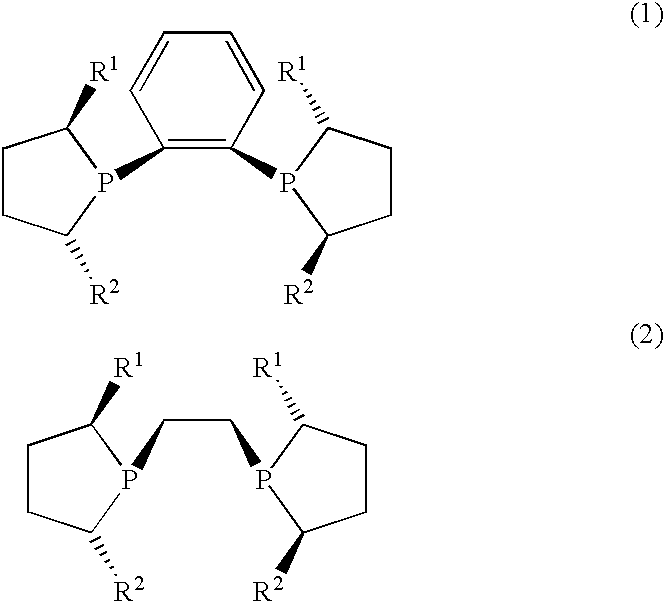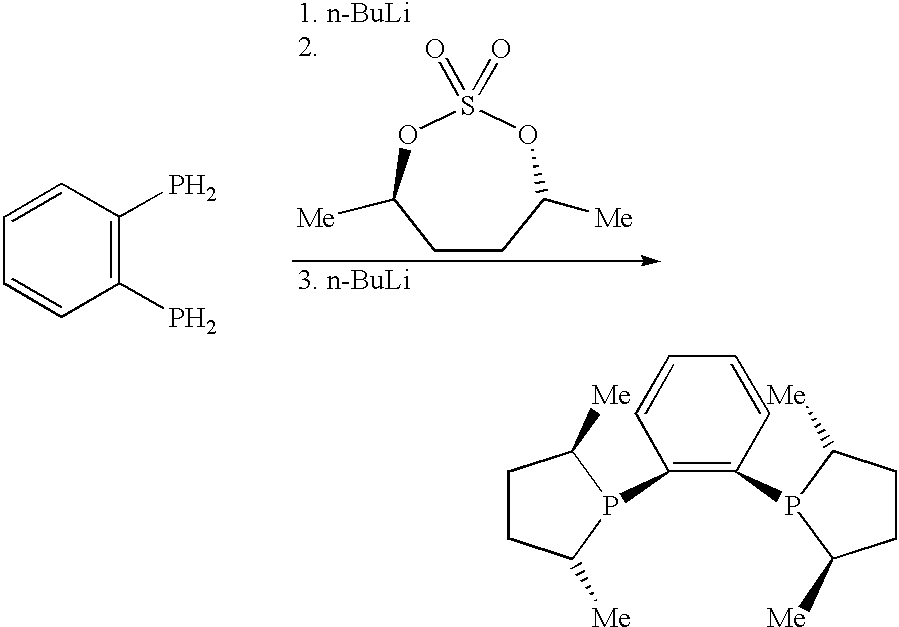Process for preparing cyclic phosphines
- Summary
- Abstract
- Description
- Claims
- Application Information
AI Technical Summary
Problems solved by technology
Method used
Image
Examples
example 1
1,2-bis((2R,5R)2,5-Dimethylphospholano)benzene (R,R)MeDuPHOS
A solution of n-BuLi in hexanes (2.958 mol; 1.183 L of 2.5 N solution), diluted with diethyl ether (2.5 L), was added over 4 hours to a stirred mixture of 1,2-bis(phosphino)benzene (100 g, 0.7042 mol) and the cyclic sulfate (4R,7R)4,7-dimethyl-2,2-dioxo-1,3,2-dioxathiepane (266.5 g, 1.479 mol, 5% excess) in TIF (8 L), under a nitrogen atmosphere, whilst maintaining an internal temperature of 10-15.degree. C. After the BuLi-solution had been added completely, the mixture was stirred for another 10 minutes, and then quenched by the addition of water (ca. 20 mL). The solvent was evaporated on a rotavapor, and to the residue was added water (ca. 1 L) to dissolve the lithium sulfate. The pH was adjusted to 3 by the addition of diluted (2 N) sulfuric acid. The ligand was extracted from this mixture with tert-butyl methyl ether (1.times.1 L, 3.times.500 ml). After drying and removal of the solvent, methanol (ca. 500 mL) was added ...
example 2
(2S,5S)-2,5Dimethyl-1-(naphth-1-yl)phospholane
A solution of n-BuLi in hexanes (21 mmol; 8.4 ml of 2.5 N solution), diluted with diethyl ether (20 mL), was added over 30 minutes to a stirred mixture of 1-naphthylphosphine (1.6 g, 10 mmol) and the cyclic sulfate (4R,7R)4,7-dimethyl-2,2-dioxo-1,3,2-dioaxathiepane (1.89 g, 10.5 mmol, 5% excess) in THF (100 ml), under a nitrogen atmosphere. After the complete addition of BuLi, the deep orange mixture was stirred for another 10 minutes, and then quenched by the addition of MeOH (2 ml). Then the solvent was removed on the rotavapor, and to the residue was added water. The product was extracted with pentane (3.times.50 ml) and, after drying the combined organic layers and removal of the solvent, the essentially pure phosphine was obtained as an oil. Yield 1.73 g (71.1% based on naphthylphosphine). .sup.31 P-NMR (CDCl.sub.3, 400 MHz): d=-6.00 ppm.
example 3
Cis- and Trans-meso-2,5-Dimethyl-1-phenylphospholane
A solution of n-BuLi in hexanes (21 mmol; 8.4 ml of 2.5 N solution), diluted with diethyl ether (20 ml), was added over 30 minutes to a stirred mixture of phenylphosphine (1.1 g, 10 mmol) and meso-2,5-di-O-tosyl-hexane (4.48 g, 10.5 mmol, 5% excess) in THF (150 ml), under a nitrogen atmosphere. After the complete addition of the BuLi, the solvent, was removed from the reaction mixture on the rotavapor. To the residue was added water, and the product was extracted with pentane in three portions (50 ml each). After drying the combined organic layers and removal of the solvent, the product was obtained as an oil. Yield 1.72 g (89.5% based on phenylphosphine) of a 88:12 mixture of trans- and cis-meso-2,5-direthyl-1-phenyl-phospholane.
PUM
 Login to View More
Login to View More Abstract
Description
Claims
Application Information
 Login to View More
Login to View More - R&D
- Intellectual Property
- Life Sciences
- Materials
- Tech Scout
- Unparalleled Data Quality
- Higher Quality Content
- 60% Fewer Hallucinations
Browse by: Latest US Patents, China's latest patents, Technical Efficacy Thesaurus, Application Domain, Technology Topic, Popular Technical Reports.
© 2025 PatSnap. All rights reserved.Legal|Privacy policy|Modern Slavery Act Transparency Statement|Sitemap|About US| Contact US: help@patsnap.com



